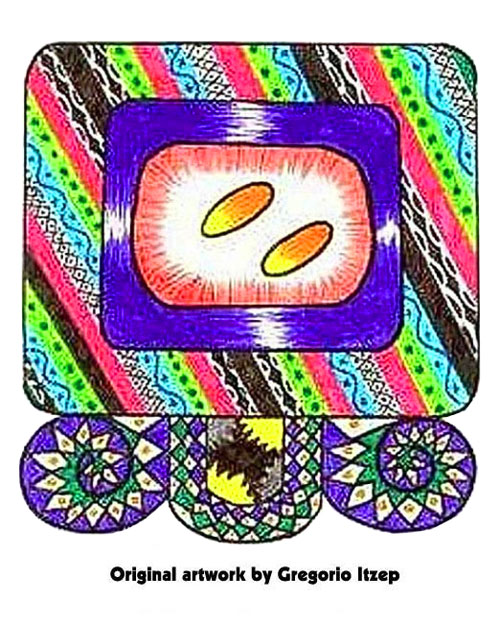
KAN TRECENA
by Kenneth Johnson
The day-sign of the Serpent is an emblem of that life-giving vital force that flows through the clouds and in the human body.
This is the archetype of Feathered Serpent once again, but this time envisioned as the primal force of the universe itself, as warmth, as the all-encompassing energy which enlivens both Heart of Sky and Heart of Earth.
Among the Yucatec Maya there were four celestial serpents, the chicchans, who guarded the four quarters of the world. When they spoke to each other, thunder was heard, presaging rain. Though the sky was their primary domain, they had a residence on earth as well: lakes, streams, and the interior of mountains were sacred to the chicchans.
However, it is more accurate to speak of four aspects of a single deity than it is to speak of four deities. This four-in-one concept is a common theme among all the peoples of ancient Mesoamerica. The four chicchans are, in this sense, four aspects of the Sky Serpent who
encircles the world—whose upper face looks toward Heaven and whose lower face forms the gateway to the Underworld.
Another aspect of the reptilian rain god was Chac, a long-nosed deity who appears frequently on the carved temple friezes of Yucatán. He was assisted in his rain-making activities by a group of helpers called chats, in whom we may recognize another manifestation of the chicchans. Chac and his attendants were known to the Aztecs as Tlaloc, the rain god, and his tlaloques.
In Anasazi petroglyphs from the American Southwest, one frequently encounters the “lightning serpent,” the image of a snake combined with the representation of a lightning bolt. This makes sense from a symbolic point of view, since rain and lightning are associated with one another. The famous Snake Dance performed by the Hopis is essentially a rain dance, for the snakes who have been chosen for the ritual will later tell the rain-making kachinas how the Hopis honored them, inducing the kachinas to shower their blessings upon the Hopis in return.
The Aztecs also linked the day-sign Serpent with the goddess Jade Skirt. Fittingly, she is the wife of Tlaloc the rain god. Jade Skirt is a goddess of love, beauty, and the life-giving water. As a goddess of both love and the life-force, her identification with the serpent power is strong. The day-sign of the Serpent is an emblem of that life-giving vital force that flows through the clouds and in the human body.
And if there is lightning in the sky, there is also lightning in the body. The energy symbolized by Chicchan is sometimes known to the contemporary Maya as koyopa. This word may refer to the sheet lightning we see playing over lakes and mountains on stormy nights, but from an esoteric point of view it refers to the “body lightning” or “lightning in the blood,” a powerful energy within the human body which may very well be identical to the Sanskrit kundalini. Both areconnected with serpent imagery. Yogic texts describe the kundalini as the “serpent power.” Bolts of lightning are regarded by the Maya as “sky serpents.” In fact, in the form of the language used during the Classic Period (200-800 CE), the word chan meant both “serpent” and “sky” or “heaven.”
If the koyopa is awake, the gods themselves may contact us directly, using the koyopa energy as a communicative medium between their world and ours. Anyone who undertakes the path of becoming a Maya priestess or priest will of course have a teacher, a “road guide.” Part of the training for such a sacred office consists of the awakening of the koyopa or lightning soul. The shamanic teacher or road guide is typically an expert diviner, healer, and dream interpreter, for the koyopa energy manifests itself powerfully in all these arts.
In times past, many of the village Maya regarded Chicchan as a somewhat dangerous day-sign, strongly associated with the arts of black magic. And yet its intense energy may also symbolize the more positive forces that we call magical; extremely high-ranking Mayan priests sometimes receive their most esoteric initiations on high-numbered Chicchan days.
It is sometimes said that Chicchan is the nawal of the creation of man and woman, and thus it is a most favorable day for sexual matters as well. This too is similar to the symbolism that pertains to the Sanskrit kundalini.
During this trecena we assert that vitality, clarity and understanding shall be made manifest right now. Because this day-sign has a connection with the inner fire or koyopa, it is also a time in which one may build both physical and spiritual strength.
http://www.jaguarwisdom.org

